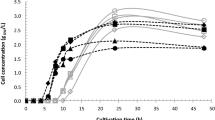Abstract
Curvularia lunata var.aeria was grown in YPD (yeast extract, peptone, and dextrose) medium (pH 6.5) at 28°C with varying concentrations (10–40 g/L) of glucose for the production of rifamycin oxidase. Enzyme activity and glucose concentration were found to be indirectly related to the production of black intracellular pigment by the organism. Depletion of glucose level and rise of culture pH initiate the synthesis of pigment. Carboxymethylcellulose (CMC) was used as a carbon source to improve the enzyme yield, but utilization of the substrate in the reactor was much less. Compared with 10 g/L of CMC in the medium, low or high concentrations of CMC did not yield any better result. Addition of glucose in YPC (yeast extract, peptone, and CMC) medium did not increase the enzyme activity, and glucose was rapidly utilized byC. lunata, forming pellets rather than mycelia.
Similar content being viewed by others
Literature Cited
Banerjee UC, Srivastava JP (1993) Effects of pH and glucose concentration on the production of rifamycin oxidase byCurvularia lunata in a batch reactor. J Biotechnol, in press
Banerjee UC, Vohra RM, Jain SC, Das S (1993) Effect of environmental factors, carbon and nitrogen sources on rifamycin oxidase production byCurvularia lunata. J Ferment Tech and Bioeng, in press
Chung BH, Chang HN, Han MH (1985) Immobilization and characterization of rifamycin B oxidase in cellulose acetate beads. Kor J Appl Microbiol Bioeng 13:115–118
Chung BH, Chang HN, Han MH (1986) Enzymatic conversion of rifamycin B in a rotating packed disk reactor. J Ferment Technol 64:343–345
Fox W (1985) La chimiotherapie de courte duree de la tuberculose pulmonaire et quelques problemes concernant son application particulierement en Inde. Bull Int Union Tuberc 60:44–54
Han MH, Seong BL, Son HJ, Mheen TI (1983) Rifamycin B oxidase fromMonocillium spp., a new type of diphenol oxidase. FEBS Lett 151:36–40
Lee GM, Choi CY, Park JM, Han MH (1984) The properties of immobilized whole cells ofHumicola spp. with rifamycin oxidase activity. Biotech Lett 6:143–148
Lee GM, Choi CY, Park JM, Han MH (1985) Biotransformation of rifamycin B to rifamycin S using immobilized whole cells ofHumicola spp. in a fluidized bed reactor. J Chem Tech Biotech 35B:3–10
Lowry OH, Rosenbrough NJ, Farr AL, Randall RS (1951) Protein measurements with Folin phenol reagent. J Biol Chem 193:265–275
Miller GL (1959) Use of dinitrosalicylic acid reagent for the determination of reducing sugars. Anal Chem 31:426–428
Sensi P, Thieman JE (1967) Production of rifamycins. Prog Ind Microbiol 6:21–60
Shepard CC (1981) A brief review of experiences with shortterm clinical trials monitored by mouse-foot-pad-inoculum. Lepr Rev 52:299–308
Seong BL, Han MH (1982) A facile preparation of rifamycin derivatives by use of manganese dioxide. Chem Lett 627–628
Seong BL, Son HJ, Mheen TI, Han MH (1983) Microbial transformation of rifamycin B: a new synthetic approach to rifamycin derivatives. J Antibiot 36:1402–1404
Seong BL, Son HJ, Mheen TI, Park YH, Han MH (1985) Enzymatic oxidation of rifamycins by a microorganism of genusHumicola. J Ferment Technol 63:515–522
Updegraff DM (1969) Semimicro determination of cellulose in biological materials. Anal Chem 32:420–424
Vohra RM, Banerjee UC, Das S, Dube S (1989) Microbial transformation of rifamycin B: a new extracellular oxidase fromCurvularia lunata. Biotech Lett 11:851–854
Author information
Authors and Affiliations
Rights and permissions
About this article
Cite this article
Chand Banerjee, U. Effect of glucose and carboxymethylcellulose on growth and rifamycin oxidase production byCurvularia lunata . Current Microbiology 26, 261–265 (1993). https://doi.org/10.1007/BF01575915
Issue Date:
DOI: https://doi.org/10.1007/BF01575915




